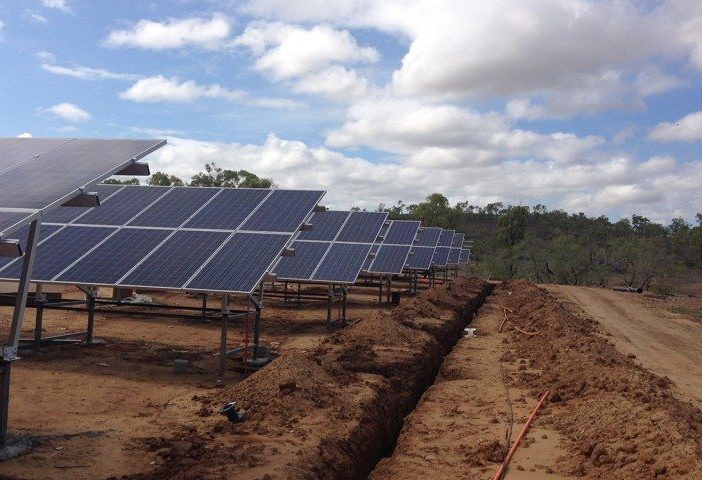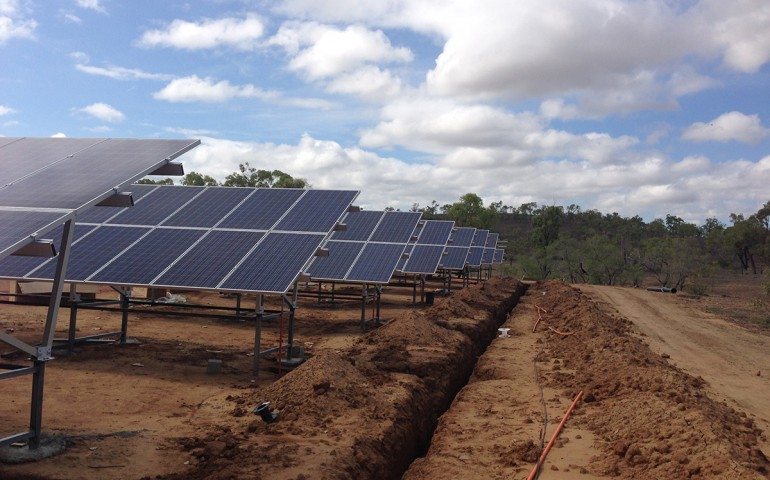
In the renewables backlash triggered by South Australia’s recent energy market woes, certain media reports painted farmers, dependent as they are on reliable and affordable power, as some of the nation’s biggest critics of wind and solar proliferation.
But a closer look reveals a very different picture. For many in Australia’s agriculture industry, distributed renewables technologies like solar and storage have come to represent a cheaper, more reliable alternative to the grid, to which many farms are connected via long, expensive and tenuous SWER lines. They are also being seen as a cheaper and cleaner alternative to the diesel fuelled generators many farmers use for either back-up or off-grid power.
On One Step Off The Grid, we’ve seen this story unfolding gradually, in such cases as reported here, here and here. But for Queensland-based solar installer Matthew Beech, the potential for solar to power farming applications like irrigation around the country is huge – and the need, even greater.

Recently, Beech’s company, Atlas Solar, installed a huge solar array (pictured above) to power a water pump system at a cattle farm in northern Queensland – the largest solar powered false bore pump on the east coast of Australia, he says.
As Beech tells it, he went to the property to fit the farmer’s house and workers quarters with solar, but wound up agreeing to quote on a job to install enough solar to pump 1.2 megalitres of water per day from a riverbed, up a 30 metre rise and then 1km to the holding dam.
“I noticed the diesel generator sitting in the dam and said, what’s going on there? And he says, ‘we’ve got to put this bloody thing in the river and it plays up like a two-bob watch.’ And I said why don’t you power it with solar?
“At first we didn’t even know if it could be done,” Beech said. “We knew we could build a solar system to any size… however we had limited knowledge of the pump side, so we engaged the services of CSWS in Toowoomba who had a man on the ground in north Queensland and, from the first site visit, we knew it was possible to build the first megalitre per day false bore pump on (Australia’s) east coast, powered entirely by the sun.”
Beech says that after much careful planning and engineering, the installation took about a week and the solar and pump system was commissioned in early November 2015. The 44kW solar array now gives the owner up to 10 hours of “run time” on clear days and four to five hours on cloudy days.
“It was an amazing feeling when the ABB pump drive was powered up for the first time and beautiful clear water was seen exiting the pipe nearly one kilometre away.

“The look on the owner’s face… he looks back on it now, and he keeps telling me I’ve changed the life of his family.
“We see enormous potential for this type of application,” Beech told One Step in an interview on Tuesday, adding that he is currently in talks with multiple industries, including fish farms, mango farms in northern Queensland, and sugar cane farms.
“I see hundreds of irrigation pumps out there, connected to filthy diesel.
“We firmly believe that the only reasons there hasn’t been more uptake (of solar) … is that it hasn’t been sold very well to the end user.”
Beech says that while solar is now “an old technology,” it is pairing it with newer technologies, such as the smart irrigation pumps used in the north Queensland project, as well as energy management software and new battery storage technologies, that makes using PV on farms such an exciting – and economic – prospect today.
“We’re marrying old technology, which is photovoltaic, to some of the newest pump drives in the market,” he said.
“That pump, the very latest from ABB (a 22kW false bore pump, pictured below)… is smarter than your average bear,” he added, noting that it can detect blockages in the pipes and cycle the water back and forth until the blockage is gone, “all while the owner is on another paddock collecting cattle.”
“If a farmer has a requirement of reliable water supply, there’s no doubt in my mind that the economics of solar would stack up in each case,” Beech said.
“A lot of the applications are going to be vertical bores, or transferring water from one damn to another.
“I can’t think of anything cheaper than filling one hole with water and being able to send it anywhere you like as long as the sun is shining. And with battery packs, you can take that to a 24 hour operation.”

And he says he sees great potential for using stand-alone solar systems to power centre pivot irrigators – the kind you find on farms in some of Australia’s driest and most remote areas.
“(Centre pivot irrigators) are everywhere,” Beech said. “They are just the future of farming… All these farms are sitting on Artesian bores that are the size of Sydney Harbour, but it’s too hard to get out of the ground, because they’ve got to get grid or diesel power (to the source). …But not any more.”
And the numbers are pretty good, too. Although there’s a high up-front cost for the systems – $150,000 in the case of Beech’s cattle farmer – the systems are paying themselves off in as little as four to five years.
“If anyone was interested in doing something like this, all they’d have to do is see it, look at the numbers, and they would do it,” Beech said.
And for the many customers, whose often expensive SWER lines are at the mercy of the elements, including extreme winds, fires and floods, the independence a solar systems provide is also worth its weight in gold.
“It’s like building your own power station,” Beech said. “That’s what the owner of the pump in north Queensland said. He said, ’At least it’s mine. I don’t have have to rely on anyone else.’
“And he said that as we were standing under a brand new power line that Ergon put in for $45,000, and it’s not connected to anything. So it’s an irony, really.”
“These (solar pump systems) can be completely self-sufficient,” Beech added. It’s all in the programming of the pump drive. There’s this little box inside a small shed (pictured right) that is the whole brains of the operation.
“So we can access live data, store data for a week, we can know what’s wrong (systems) and fix them over the internet, before the farmer even knows.”
So what’s stopping farmers from doing this? Aside from a lack of knowledge, its mostly a lack of access to ready funds, says Beech.
“We’ve talked to people like Barnaby Joyce and these guys are all for it, they love the idea, but you can’ get much out of them (in terms of government assistance).
“It’s really up to the owner and the solar company to make it work.”
But, he adds, “the numbers do not lie. Once you’ve got that system paid off, in four to seven years, you’re left with panels that will last 25 years, a pump that will last 10-15 years – I can’t imagine a decent bank manager looking at a project like this and not seeing the returns.”

Sophie is editor of One Step Off The Grid and deputy editor of its sister site, Renew Economy. Sophie has been writing about clean energy for more than a decade.



